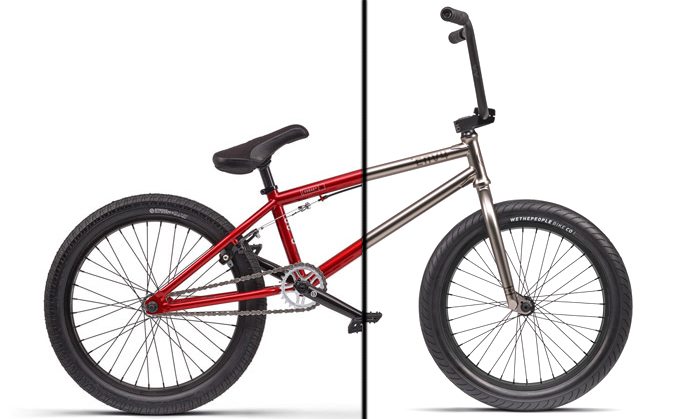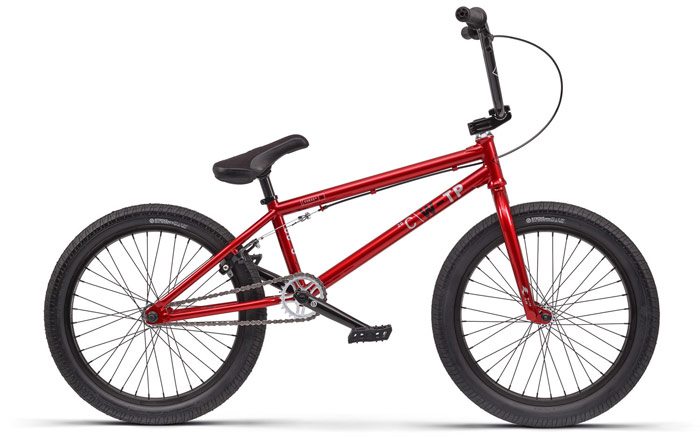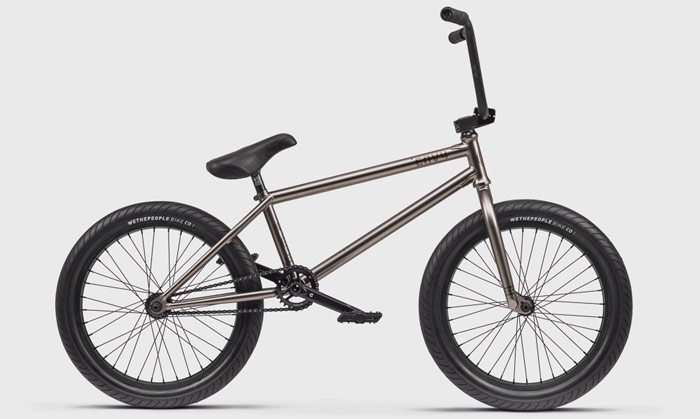
If you have spent some time on Instagram looking through hashtags for different brands, there’s something that you most likely have seen a time or two. People who like to use their accounts to inform brands and their followers that they broke a part and that they now hate that brand because it failed to withstand the abuse they were putting it through. This is especially the case when it comes to complete BMX bikes that are usually the first bike for a rider. In fact, this really does apply to virtually any product you might bolt on to your bike… Did you catch our What Does A Warranty Cover? post? But today we’re going to talk a little bit about why an inexpensive complete BMX bike might break before a higher end bike would.
When it comes to complete BMX bikes in 2016 versus what they were five or 10 years ago, it’s like night and day in quality, but that doesn’t mean they’re indestructible. Like pretty much every piece of equipment you can buy, the saying “you get what you pay for” is really about as true as it gets. Most BMX brands that offer complete bikes have a pretty wide spectrum of prices on their bikes and that’s because they offer different levels of quality. Let’s take a look at an example below comparing an “entry level” complete bike with a “high end” complete bike…

Wethepeople Curse – $379.99
Frame: 4130 crmo down tube, 1020 hi-ten
Fork: SALT “AM 20” fork, 1020 hi-ten , 4130 crmo steerer, 28mm offset
Bars: 1020 hi-ten
Grips: WETHEPEOPLE “Arrow 146” Vex compound grips
Stem: SALT “PRO V2” top loading stem, 50mm reach
Headset: SALT “PRO” int. headset, sealed bearing
Gyro: no / holes for removable gyro tabs
Lever: SALT “AM” alloy brake lever
Brakes: SALT “AM” alloy u-brake rear
Cranks: SALT “Rookie” tubular 3pc crank crmo 170mm, 8 Spline
BB: SALT “MID” 19mm, press fit, sealed bearing
Pedals: ÉCLAT “Surge” nylon/fiberglass pedals
Chain: SALT “AM” chain, 510h type
Sprocket SALT “AM” steel 26t sprocket
Driver: 9t, 1pc cassette driver, sealed bearing
Front Hub: SALT “AM” alloy hub, loose ball 3/8”s axle, 36h
Rear Hub: SALT “AM” cassette hub, full sealed, 9t, 14mm axle, 36h
Hubguards: –
Front Rim: SALT “Valon” rim, straight single wall, 36h
Rear Rim: SALT “Valon” rim, straight single wall, 36h
Seat: WETHEPEOPLE “CURSE 20” pivotal seat
Seat Post: SALT “AM” pivotal seat post
Seat Clamp: SALT “AM” alloy seat clamp
Tires: SALT “Strike” 2.35″ front / “Strike” 2.2″ rear
Pegs: SALT “AM” steel pegs (1 pair)
Weight: 11.8kg (26lbs) w/o pegs & front brake

Wethepeople Envy – $1099.99
Frame: WETHEPEOPLE “Envy” frame, 4130 full sanko, tapered CS and SS, removable pivots & guides, intg. chain tensioner
Fork: WETHEPEOPLE “Envy” fork, full 4130 sanko with post liquid heat-treated, 1pc cnc steerer, 28mm offset
Bars: WETHEPEOPLE “Envy” bars full 4130 sanko, post liquid heat-treated, 25.4mm clamping
Grips: ÉCLAT “Filter” Vex compound grips
Stem: WETHEPEOPLE “Hydra” cnc alloy top loading stem, 25.4mm clamp, 27mm rise, 50mm reach
Headset: SALTPLUS “Echo” int. headset, sealed bearing
Gyro: no / holes for removable gyro tabs
Lever: ÉCLAT “Sniper” hinged alloy brake lever, two finger version
Brakes: ÉCLAT “Unit” u-brake and bridge cable rear
Cranks: ÉCLAT “Spire” 2.5 pc crank, crmo, 170mm, 48T spline, 22mm spindle
BB: ÉCLAT “CNC” mid size, press fit, sealed bearing
Pedals: ÉCLAT “CONTRA” nylon/fiberglass pedals, removable pins
Chain: SALTPLUS “WARLOCK” halflink chain
Sprocket ÉCLAT “Vent” 6016-T6 alloy, cnc, 26t sprocket
Driver: 9t, 1pc free-coaster driver, RSD
Front Hub: ÉCLAT “Pulse” hub, 3/8s” female bolts, 36h
Rear Hub: ÉCLAT “Cortex” freecoaster hub, sb, 9T, 14mm hollow axle, 36h
Front Rim: ECLAT “Bondi V2” straight double wall rim, 36h, flash welded
Rear Rim: ECLAT “Bondi V2” straight double wall rim, 36h, flash welded
Seat: ÉCLAT “Oz V2” thick padded pivotal seat
Seat Post: WETHEPEOPLE 3D forged alloy pivotal seat post 200mm
Seat Clamp: integratedseat clamp
Tires: WETHEPEOPLE “Stickin” 2.4″ front/ 2.3″ rear
Weight: 11.6kg (25.5lbs) w/o pegs & brakes
Note: We’re just using these bikes as examples and in no way are we saying you will break these bikes faster than another brand or that certain bikes or parts won’t last for a long time. We’re just looking at it from a broad standpoint to explain why one bike is designed to be more durable than another and why one bike can cost less than another. Wethepeople make some amazing bikes for all levels from entry level to high end and that’s why we chose to use their bikes as an example. What we talk about can be applied to any BMX brand.
Alright, so, we’re going to compare two bikes on very different spectrums to make this a little easier to understand. Above are two bikes from Wethepeople that are on two completely different spectrums on price and quality. Both bikes look great to the untrained eye, but when you are familiar with materials and processes, you begin to see where things are different.
Let’s start out with the frames. The Curse is made with a 4130 chromoly down tube and 1020 hi-ten steel. That means that everything but the down tube is steel. The Envy is Sanko 4130 chromoly tubing from front to back. What’s the difference? Strength and weight. 4130 chromoly tubing is stronger and much lighter than hi-ten steel. So, if you were to put the same rider on both bikes and do the same style of riding, the Curse would be much more likely to fail before the Envy frame. But that’s not the only difference, Wethepeople have added tapered tubing, removable brake guides and a number of other features that add to the overall cost of producing the Envy frame.
Next, we can compare the forks and bars. The Curse features a 4130 steerer tube, and 1020 hi-ten steel legs and full 1020 hi-ten steel bars. On the other side, the Envy features full 4130 chromoly on both. The Envy fork and bars are also heat-treated which is a process that, by heating and cooling the chromoly, makes the material even stronger. You can learn about heat-treating here: What Is 4130 Chromoly and Heat-Treating
The cranks on both bikes are 4130 chromoly, right? True, but there’s big differences in the two cranks. The Curse features 3-piece tubular chromoly arms with an 8-spline spindle with pinch bolts. The Envy cranks are 2.5-piece chromoly arms with a 22mm, 48-spline spindle. So, first off we can assume the cranks on the Envy are much lighter because they only require one bolt to keep both arms tight on the cranks, where the Curse cranks feature two bolts to hold the cranks on to the spindle, and 2 bolts to pinch the arms on to the spindle to keep them in place tight. The Envy cranks are 22mm, 48-spline versus the 19mm, 8-spline on the Curse. The larger spindle is stronger and having 48-splines make it harder for you to strip out the splines.
Which cranks would you be more likely to break if you were to put the same rider through the same riding on both? The cranks on the Curse would have a much higher chance of breaking. This is one of those differences that helps keep the Curse’s price much lower than the Envy.
Now, let’s compare the wheels. The Curse features an unsealed front hub with a sealed 9-tooth cassette hub in the back, both laced to single wall rims that are likely pinned versus welded. The Envy features sealed hubs front and back, a freecoaster hub in the rear and double wall, flash welded rims. Once more, when you put the same rider, doing the same style of riding on these wheels and you’re much more likely to see the Curse’s wheels blowing out, hopping and out of true because they are of a lesser quality. Also, with the popularity of freecoaster hubs and the fact that they’re more technical than a cassette hub, they come with a more premium price as well.
When you compare the remaining parts of the bikes against each other, you will find terms like “CNC machined”, “heat-treated” and “sealed” on the Envy, where you won’t find those things on the Curse. Also, if you look at the brands for the parts that are available on both bikes, you can find a few different names. Wethepeople, Eclat, Salt and Salt Plus are all brands under the Wemakethings company. Wethepeople and Eclat are the brands premium products that are higher quality with better materials and different processes applied to them to create stronger, more reliable products. Salt and Salt Plus are sub brands that they have created that feature products that are more inexpensive and don’t feature all the same bells and whistles that you can find on the higher quality Wethepeople and Eclat parts.
The differences in the quality of materials and processes to create these products are what creates such a gap in prices. The Curse would be a great entry level bike for somebody just getting into BMX, where the Envy is a bike that’s designed for the rider that has been riding BMX already, and wants a bike they can get for a great price that’s going to hold up to more advanced riding and tricks that is comparable to if they built a completely custom bike with high quality after market parts.
One thing we should also note is that typically you will find warranty options on higher quality products that cover bending and breaking (not necessarily on complete bikes unless they utilize aftermarket components like the Envy), but you won’t find them on lower end bikes.
This can be applied to every single BMX brand that produce complete BMX bikes whether it be Fit Bike Co., Cult, Flybikes, Volume Bikes, Colony, Subrosa, Kink, Haro, Stolen, United, Verde, etc. The more expensive the bike, the higher the quality the materials and components being used on the bike.
So, to come back around full circle to where we started. The reason why your complete BMX bike is broken is most likely due to the level of riding being done on the bike is harder than the quality it was designed for. Single wall rims will bend easier than double wall rims, 1020 steel is more likely to crack and break than 4130 chromoly.
Is it the brands fault these products break? Unfortunately it reflects bad on them, but it’s not their fault and quite honestly most times out of 10 they shouldn’t be responsible for replacing a part unless it’s due to a manufacturers defect. When we say manufacturer defects, we mean poor welds that are already cracked or cracked easily, defective materials, bent tubing, dented tubing, etc. that wasn’t caused by you because of riding. I highly suggest you check out the What Does A Warranty Cover? piece we did that explains what is typically covered when it come to warranties.
No single BMX product is indestructible and regardless of just how high quality the materials, how perfect the welds and design is… There will always be a way to break it. Whether you’re dropping a 5 stair out on the streets, coming down heavy from blasting a huge air over a box jump, grinding rails and ledges, casing a landing, throwing your bike after a trick doesn’t work out… Bikes break. Just know that going on Instagram to tell all your followers that you snapped your cranks on your $375 complete bike because you dropped a huge stair set 10 times, on top of all the other riding you probably did before that, and that brand sucks because they won’t give you new ones is because you paid for a product that wasn’t designed to take that kind of abuse.
This doesn’t even get into if your bike isn’t properly assembled or maintained, which can lead to a ton of problems that cause your bike to fail early as well. Check out this video on How To Build A Complete BMX Bike out of the Box.
Hopefully this helps people understand that you definitely get what you pay for when buying a BMX bike.
We want to hear from you! Let us know what you think in the comments below!
VISIT: FRONT PAGE // DAILY SECTION // BMX COLOR APP // BMX VIDEOS // RANDOM
